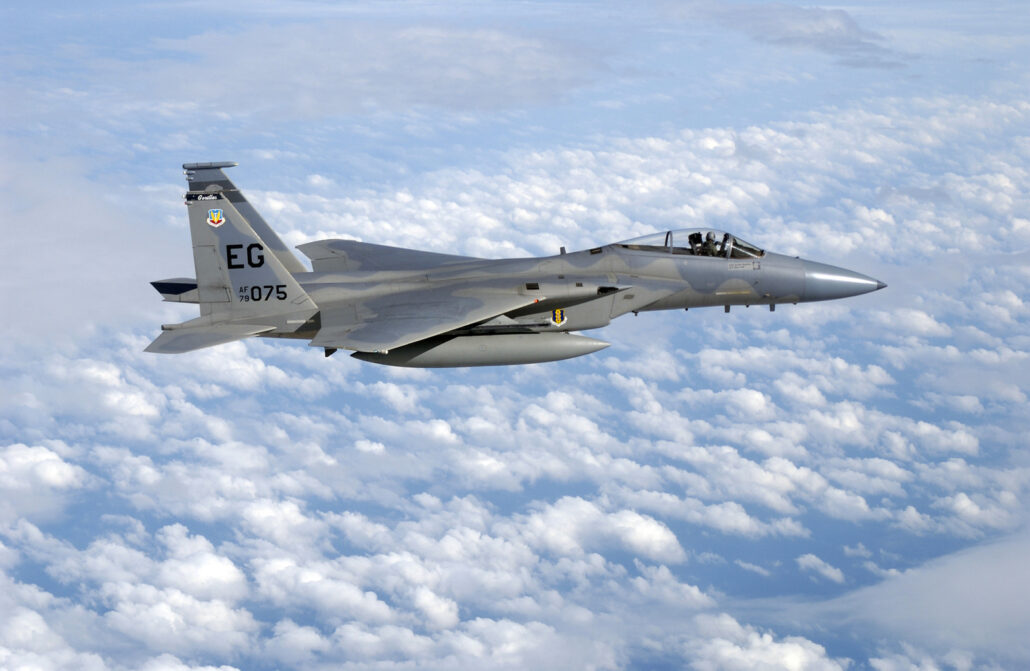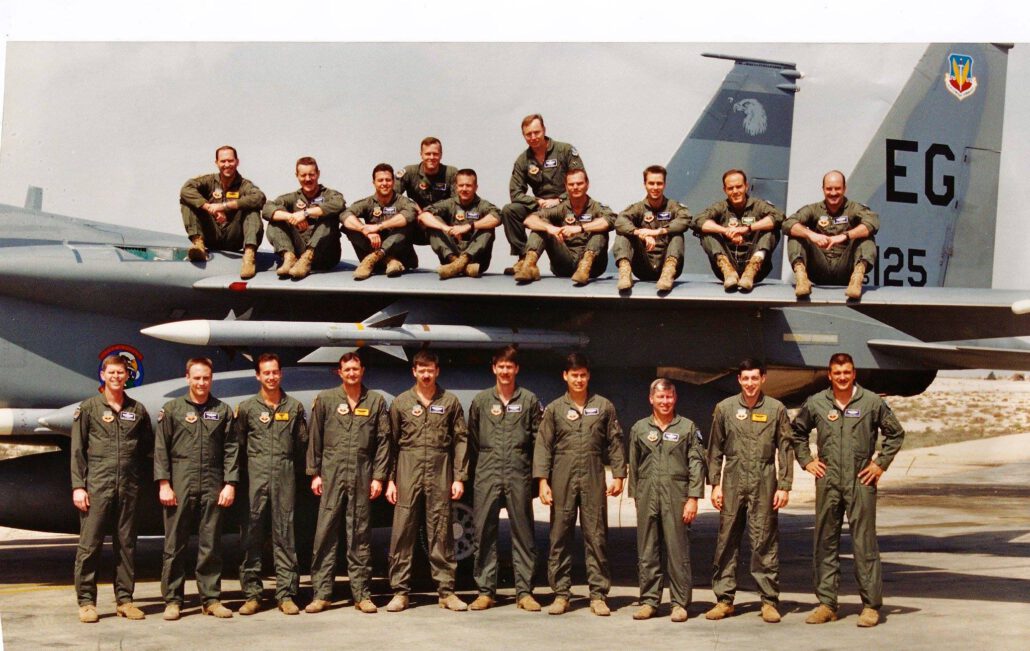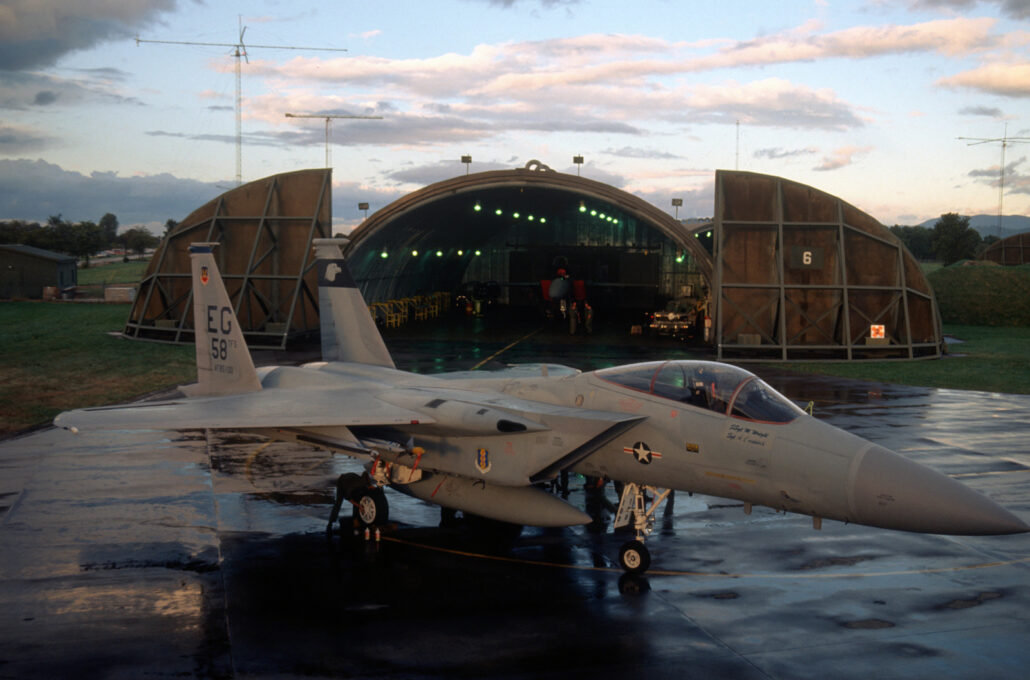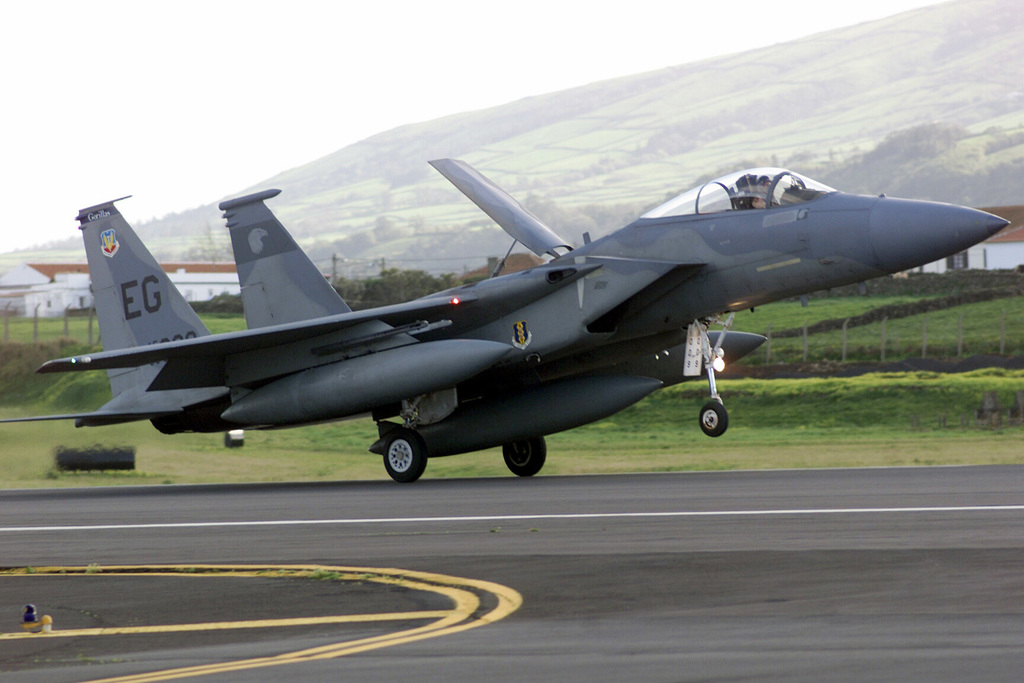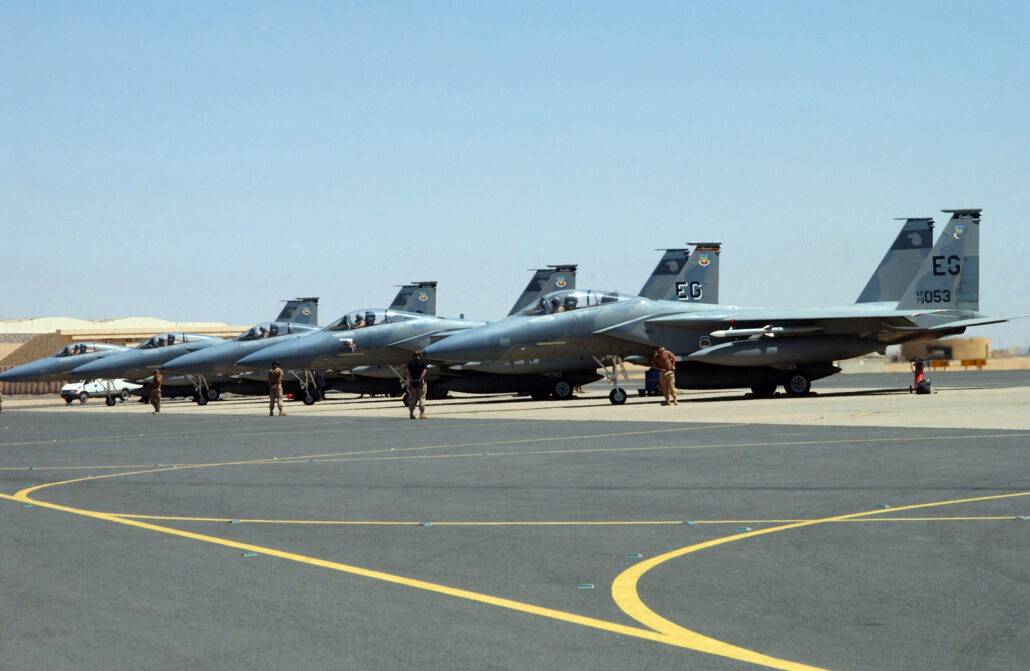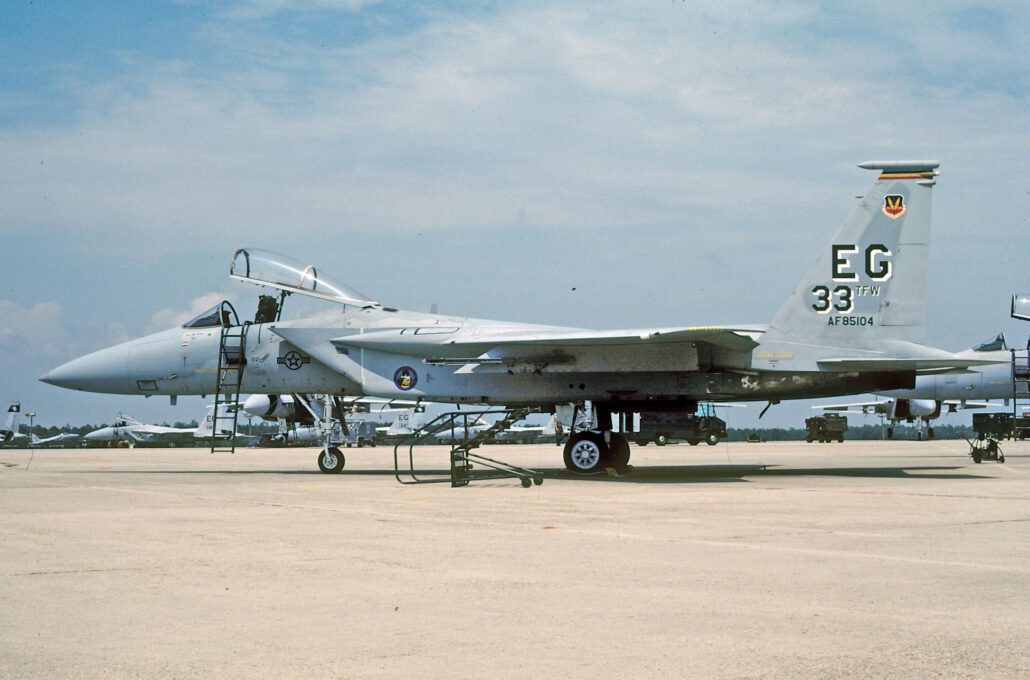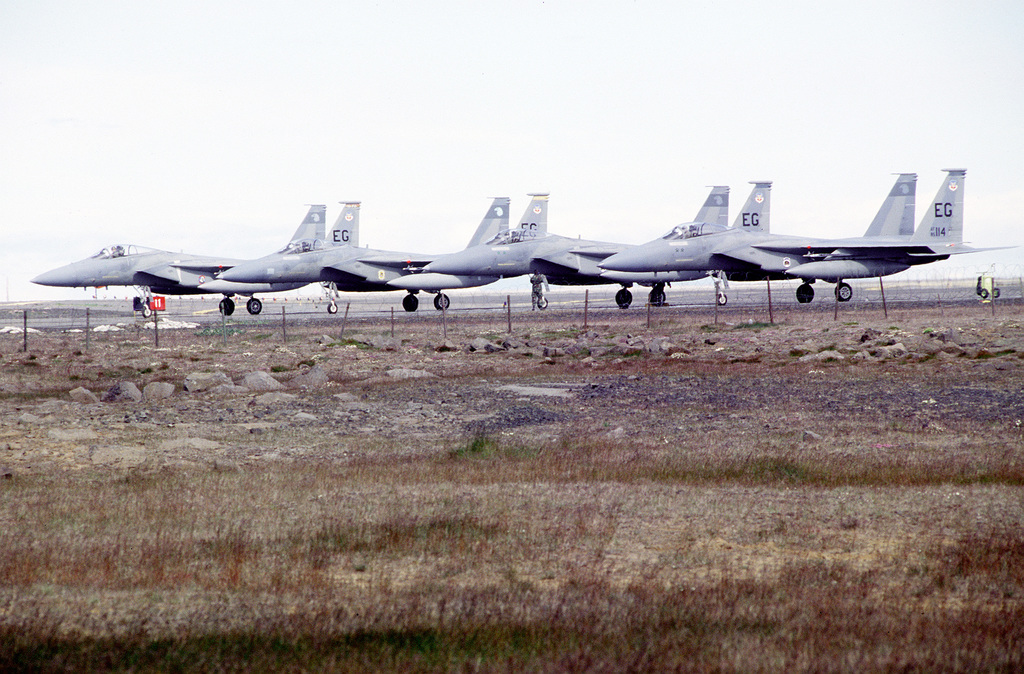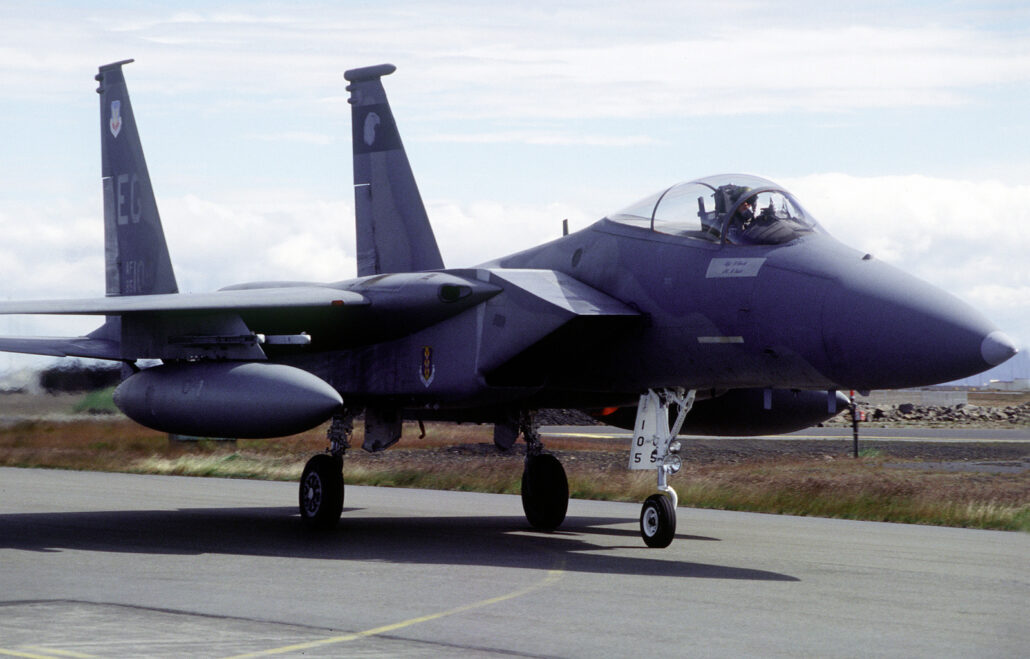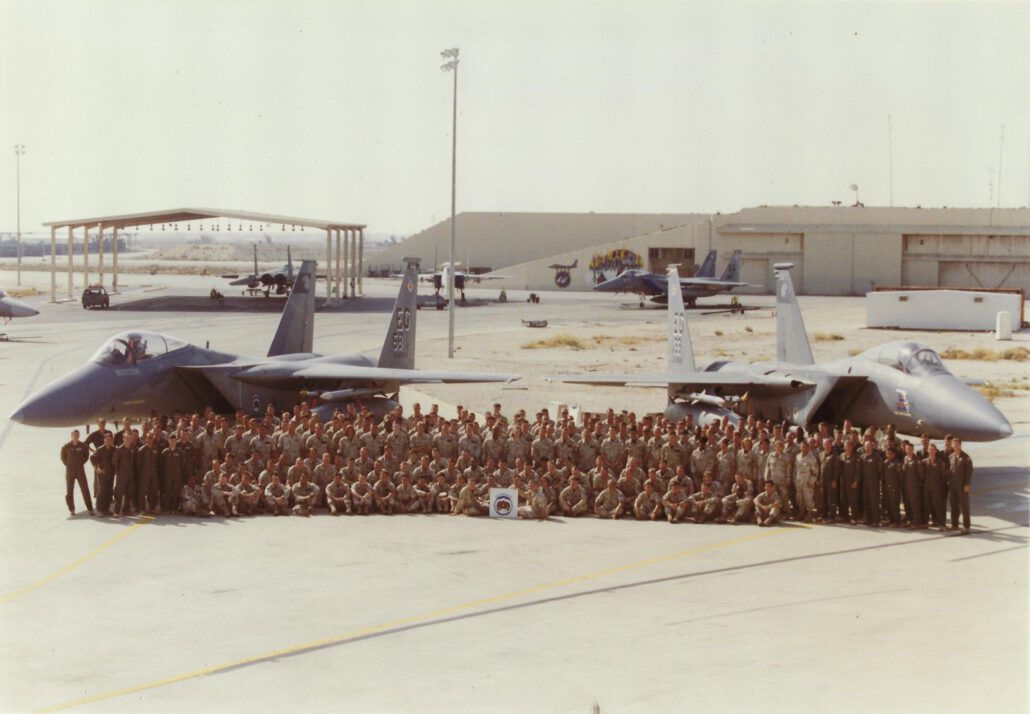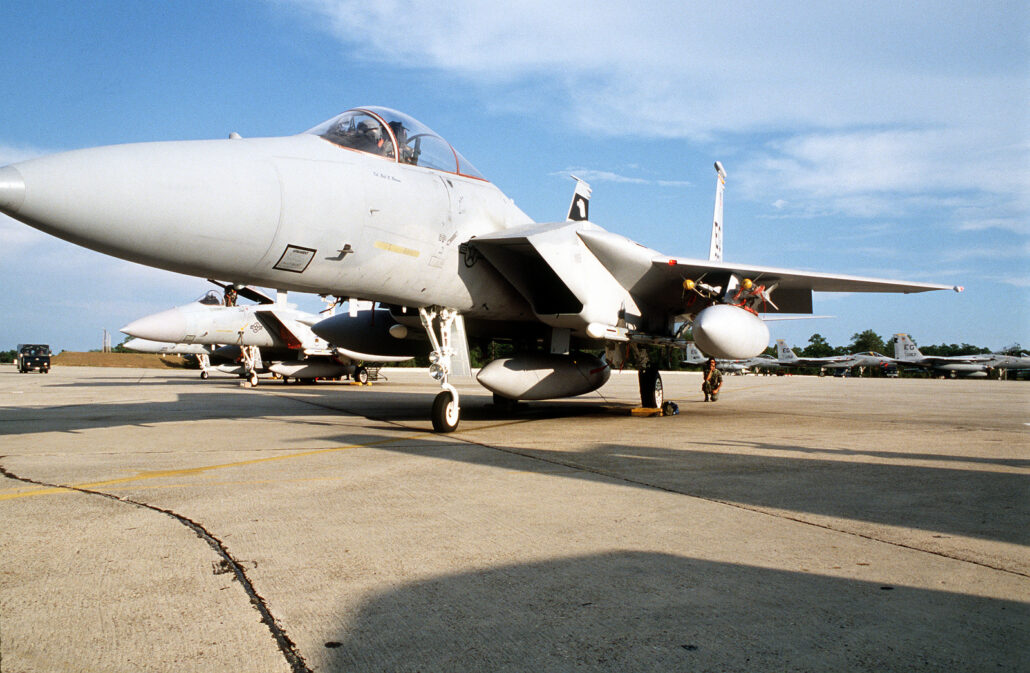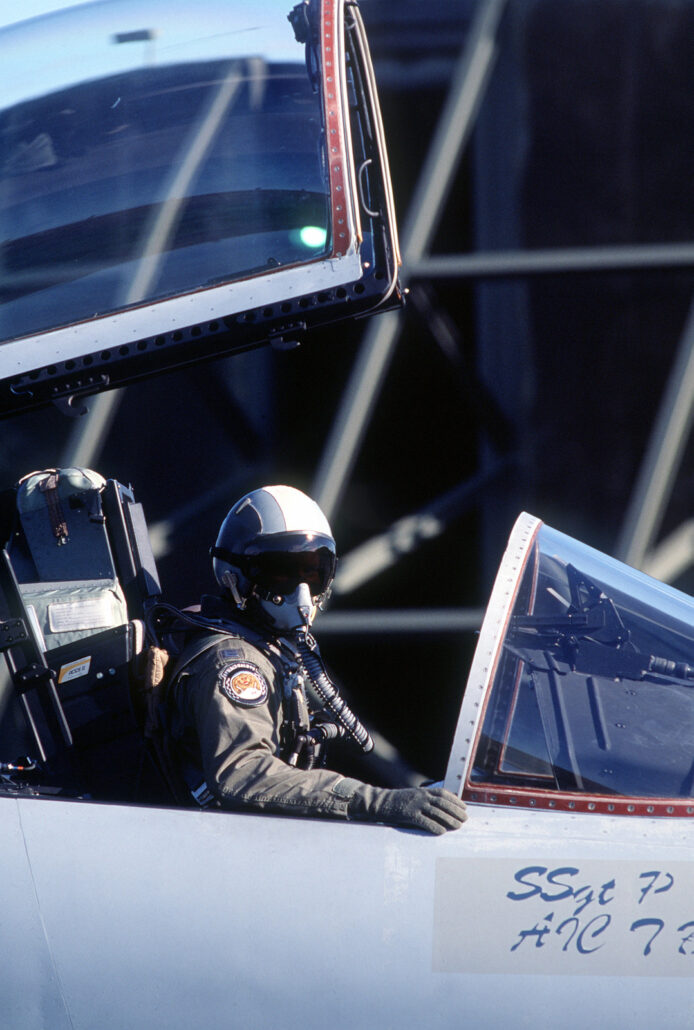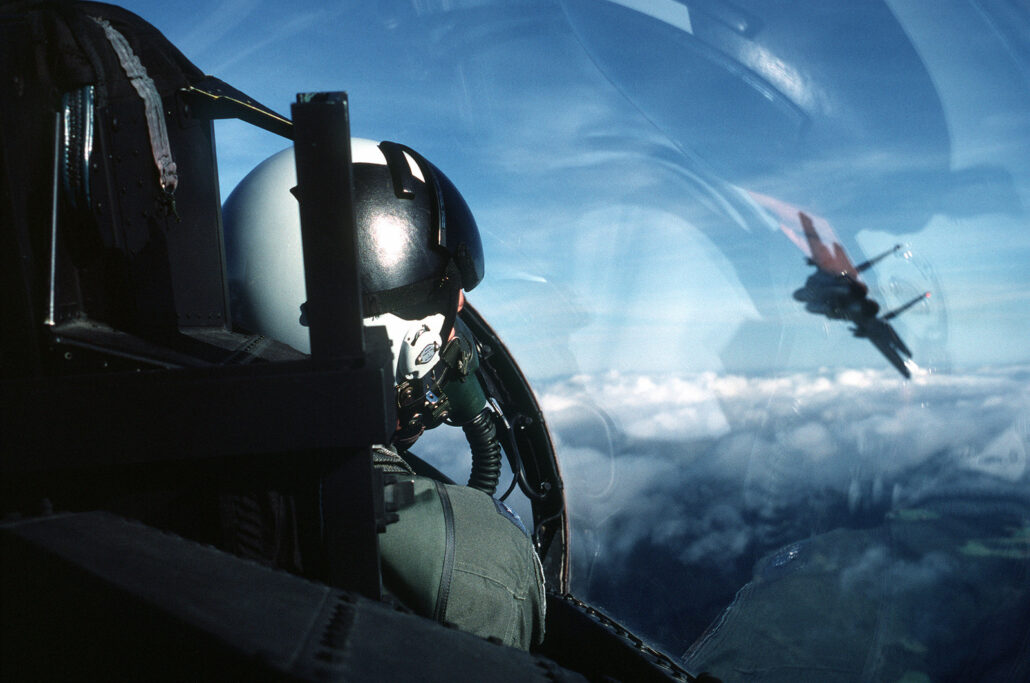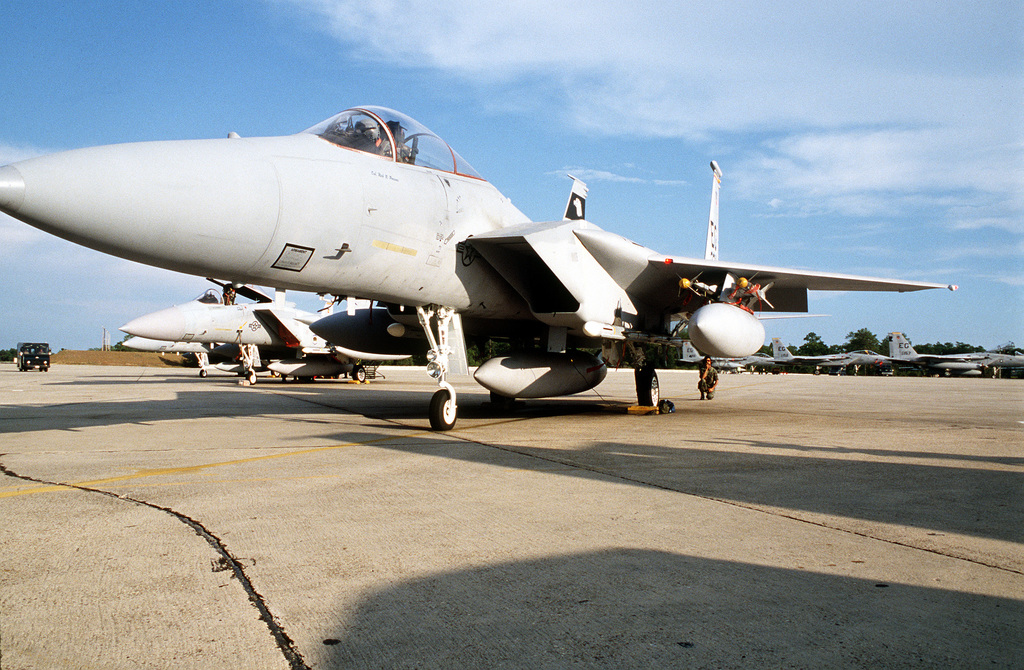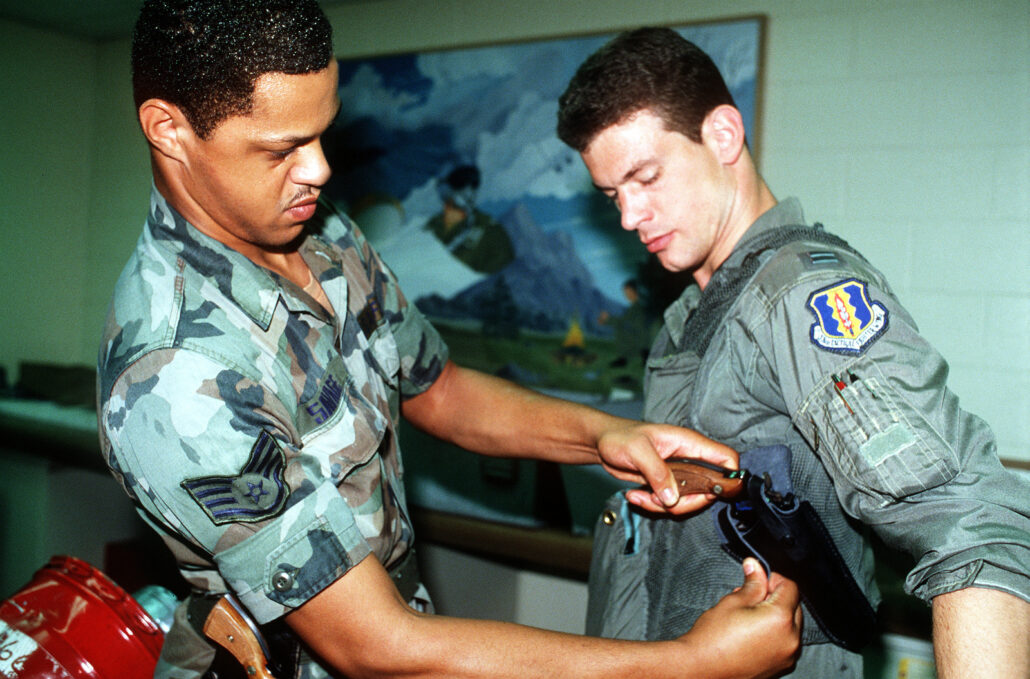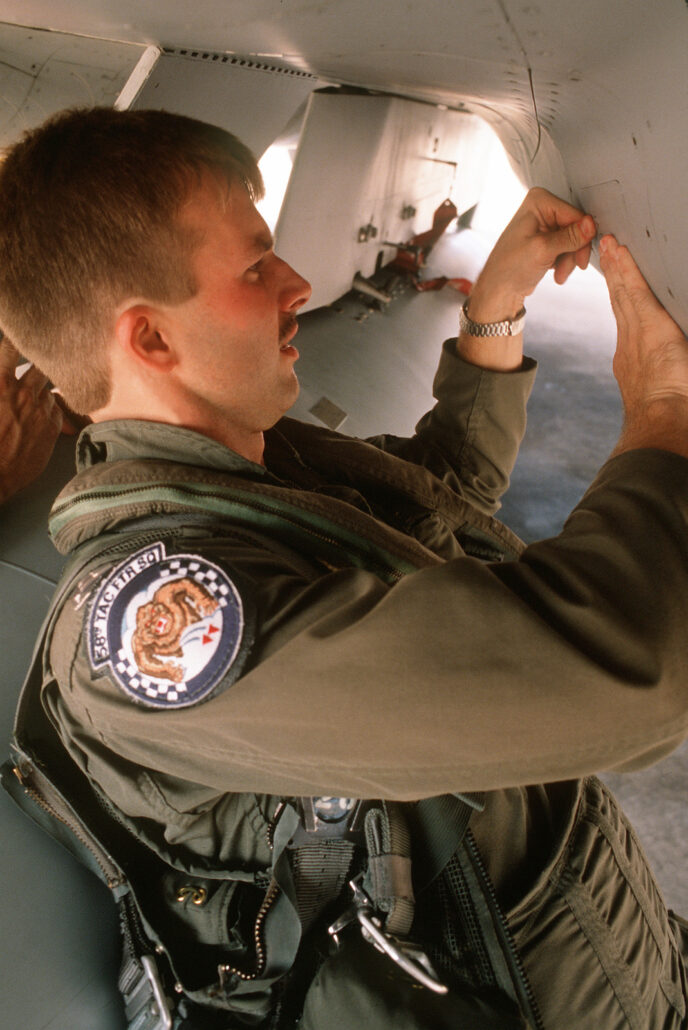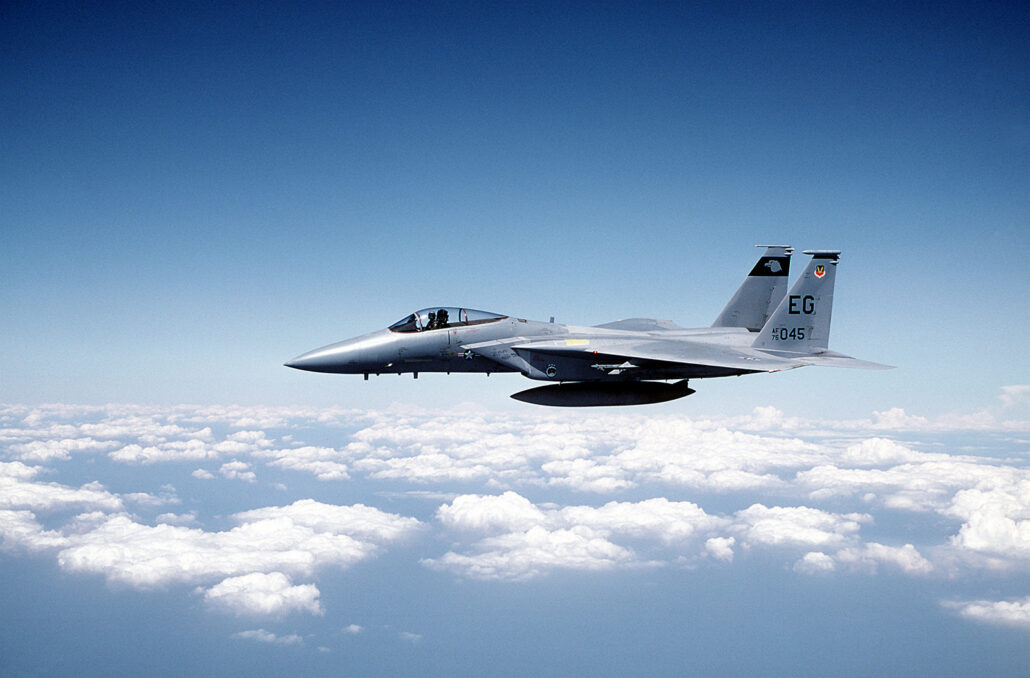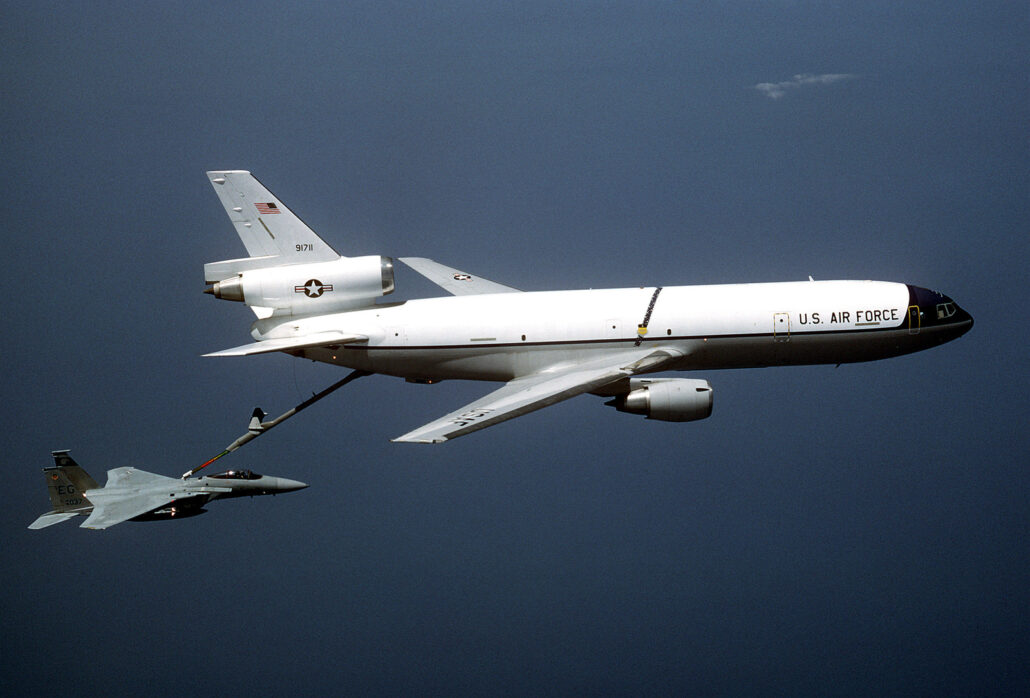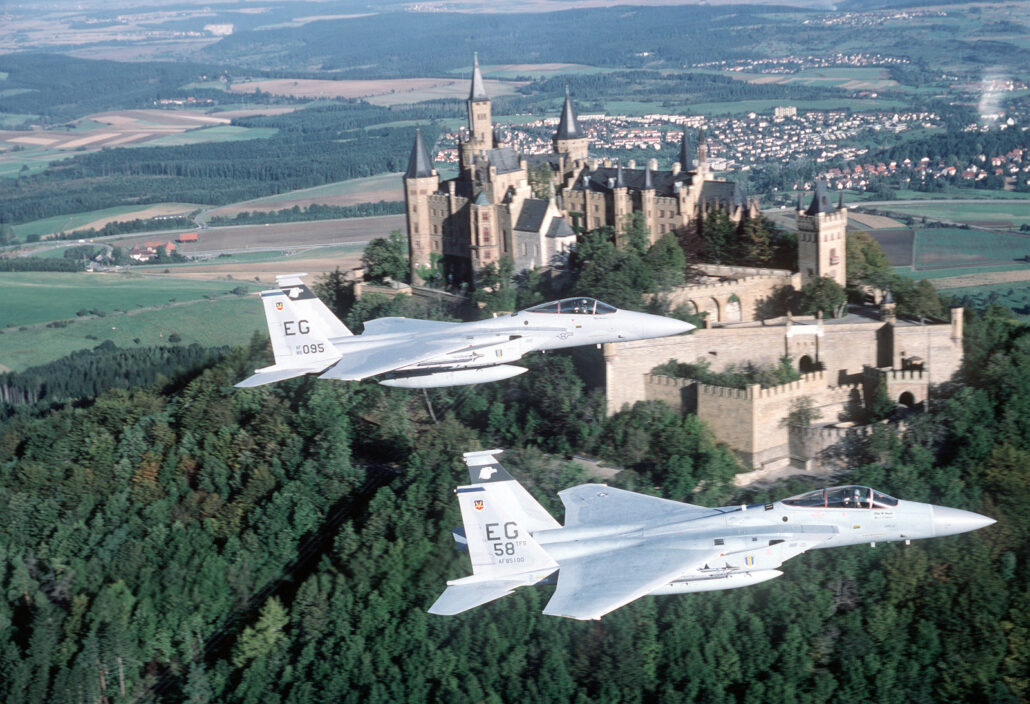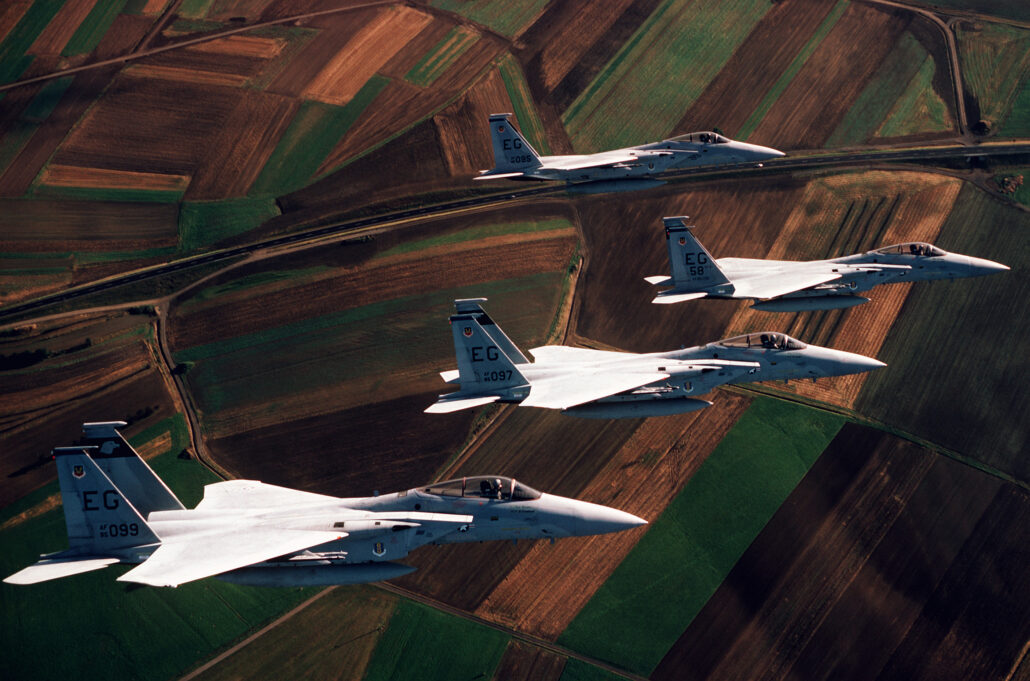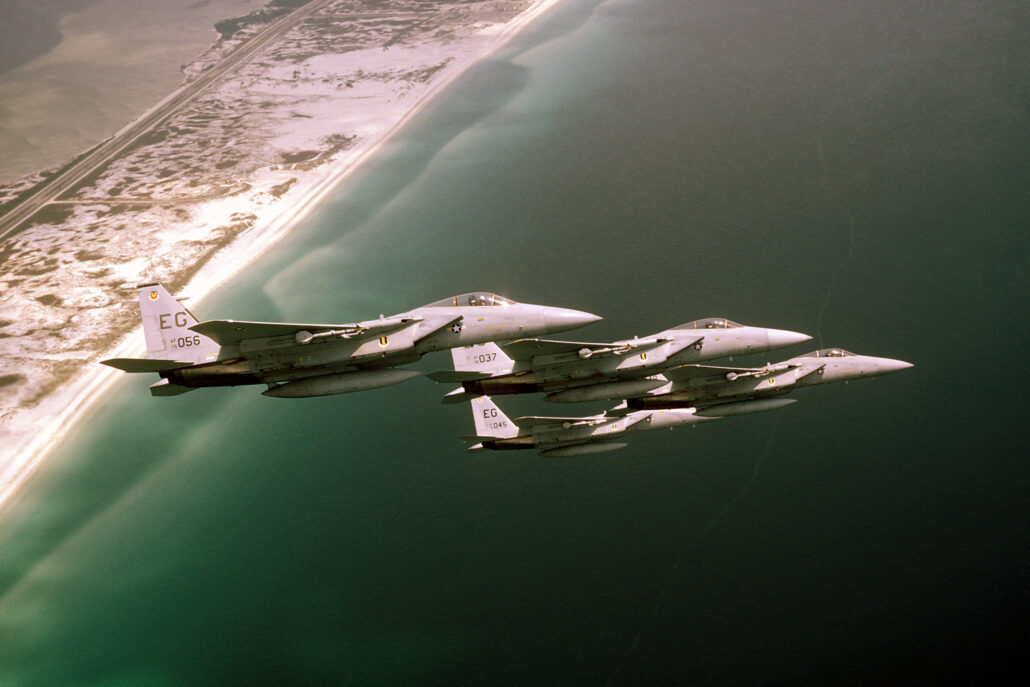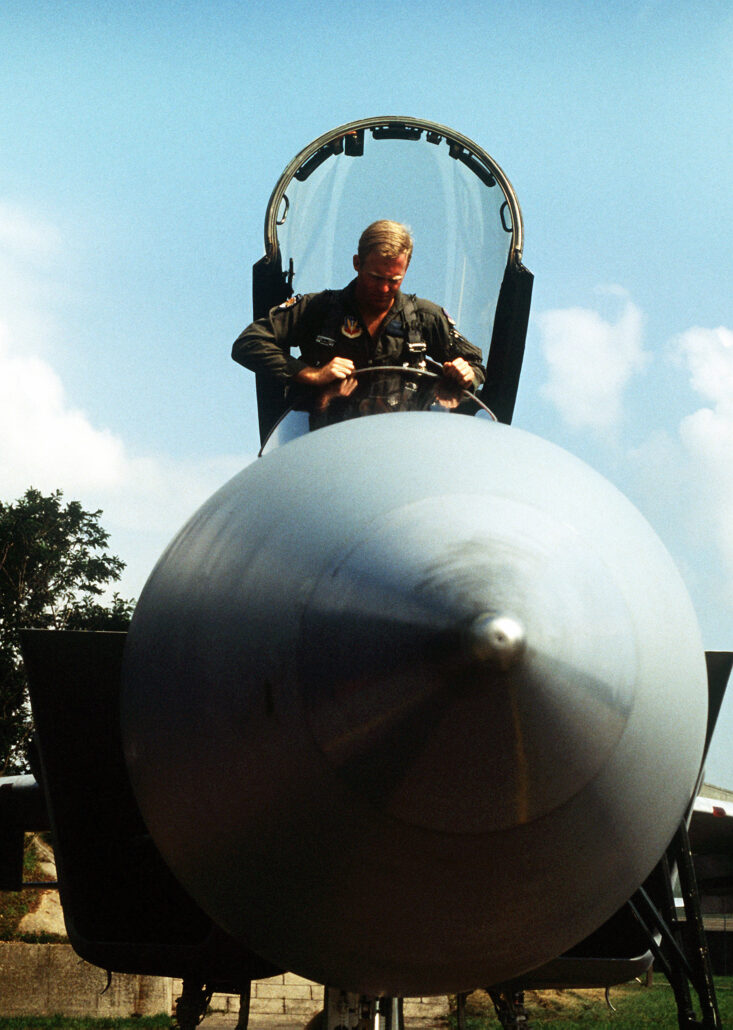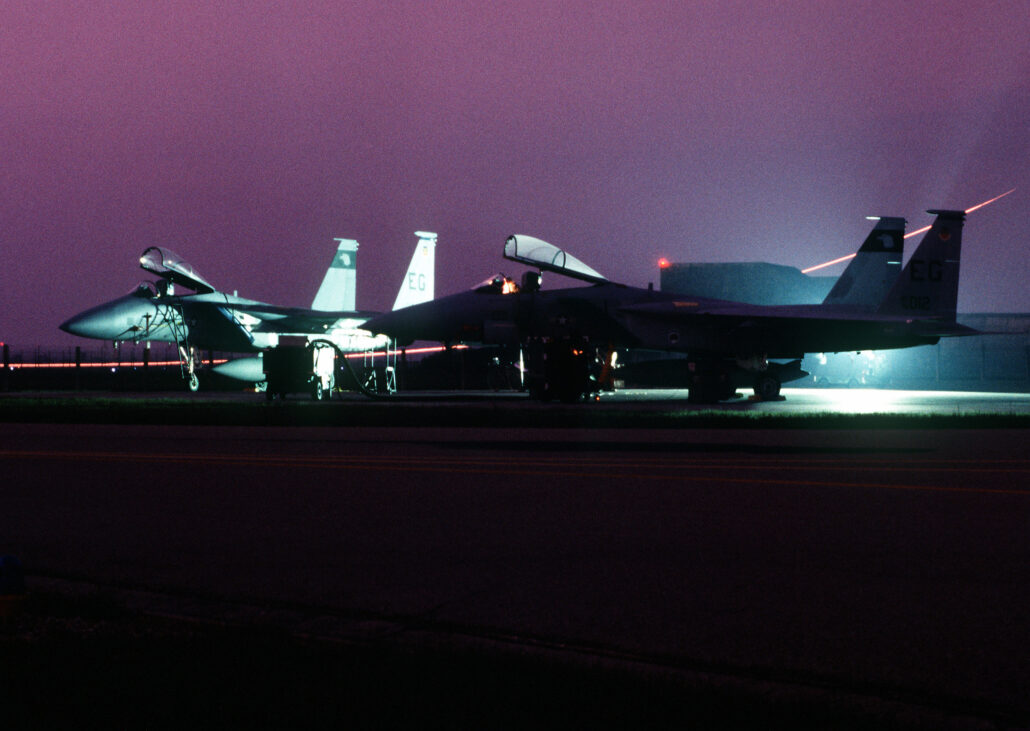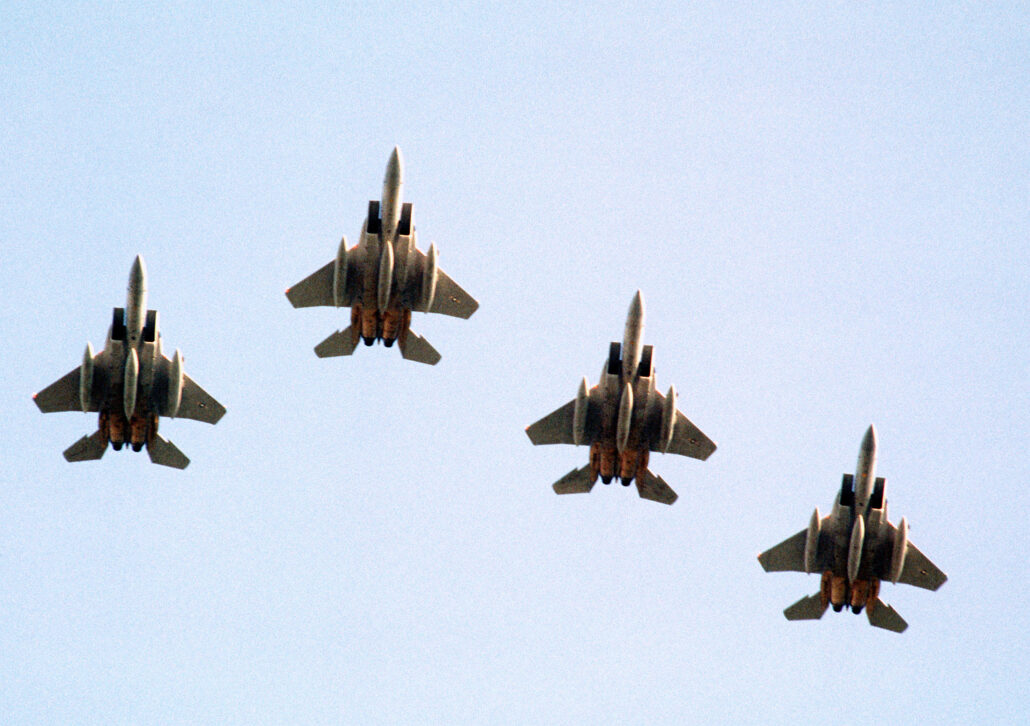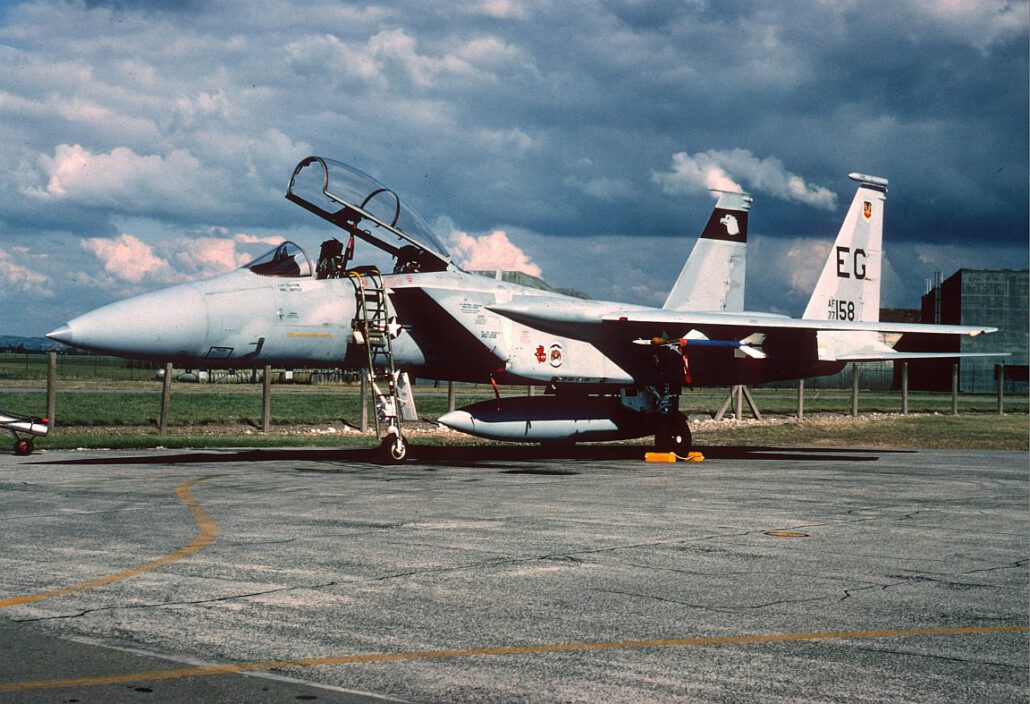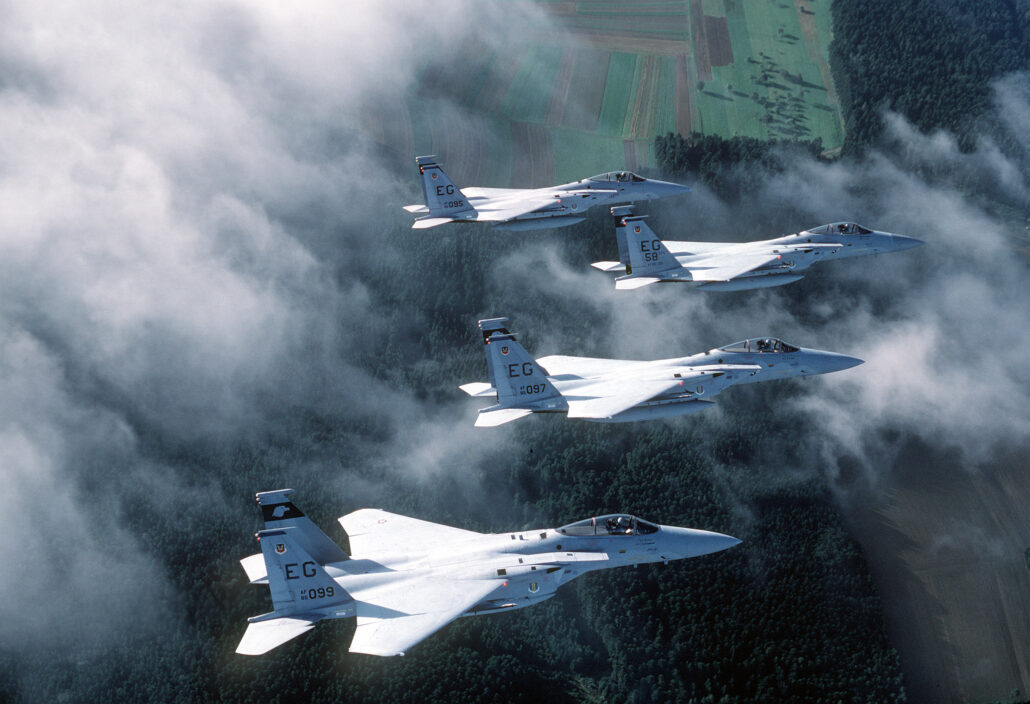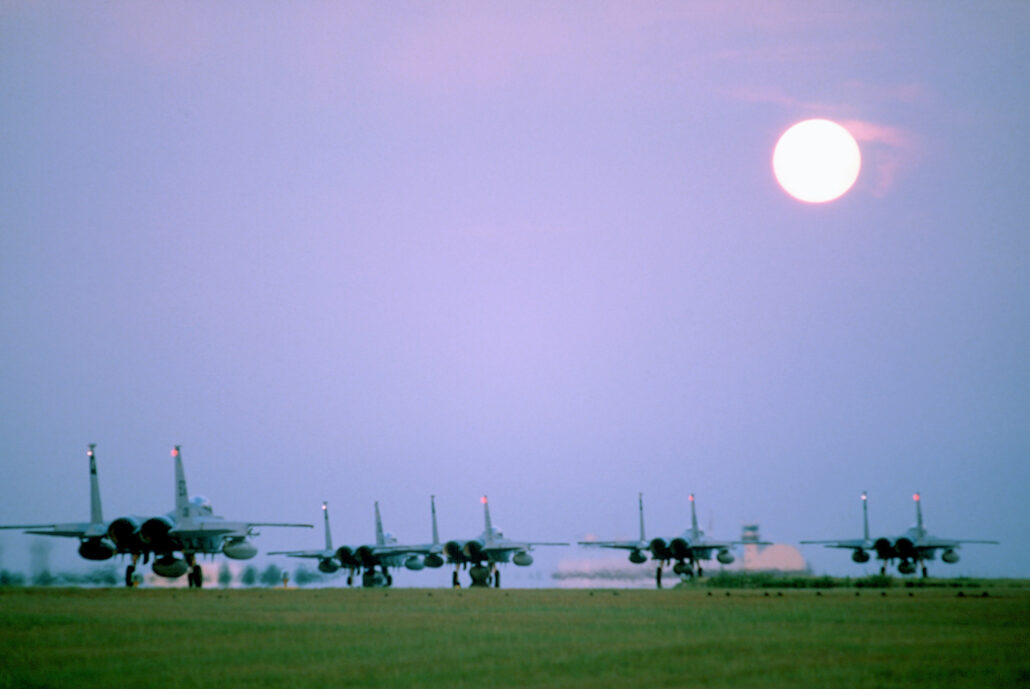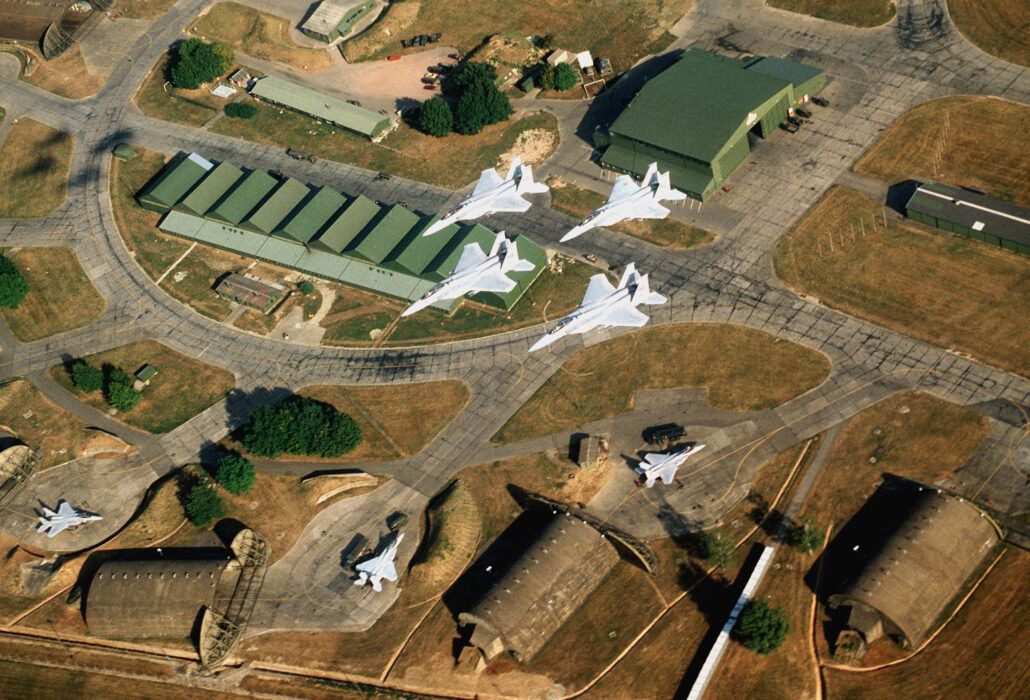Gorillas
Eagle History
The 58th Fighter Squadron is stationed at Eglin AFB, Florida. In 1979, the 58th Fighter Squadron became the first squadron in the 33d Tactical Fighter Wing to receive the F-15 Eagle. The 58th proved the war fighting capability of the F-15 during its deployment to Germany for exercise Coronet Eagle. During the exercise, the 58th utilized 18 F-15s to fly 1001 sorties in less than three weeks. The unit repeated this deployment in 1982 utilizing 24 F-15s making it the first full F-15 deployment in history.
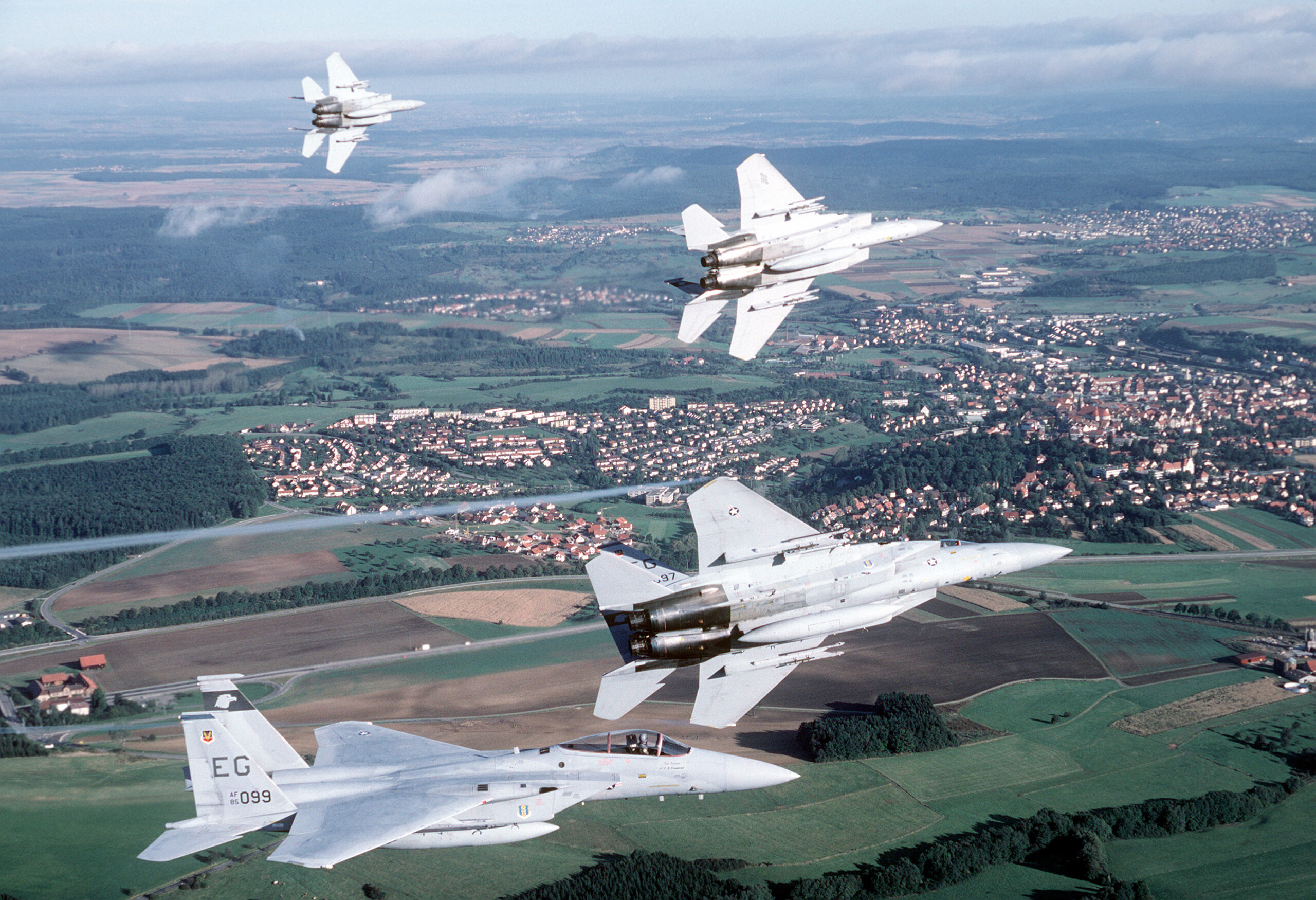
Ten years later, the 58th participated in Operation Just Cause where forces successfully removed Panamanian dictator Manuel Noriega from power in Panama.
The 58th was once again called upon to prove its mettle in August of 1990
when Saddam Hussein invaded the tiny country of Kuwait. Twenty-four F-15s under the command of Colonel Rick Parsons departed Eglin Air Force Base for King Faisal Air Base, Saudi Arabia as part of the build up of coalition forces in Operations Desert Shield and Desert Storm. In the early morning hours of January 17, 1991, Operation Desert Storm commenced. Captain John J.B. Kelk claimed the first aerial victory by downing the first MiG-29. As the war progressed, the 58th flew 1,689 combat sorties and destroyed 15 other enemy aircraft. During the course of the war, the 58th accomplished feats that no other coalition member matched including: the most air-to-air kills, the most double kills, and the most sorties and hours flown by any F-15 unit in theater. The 58th also destroyed the most MiG-29s (a total of five) and had the only wing commander who had an air-to-air victory.
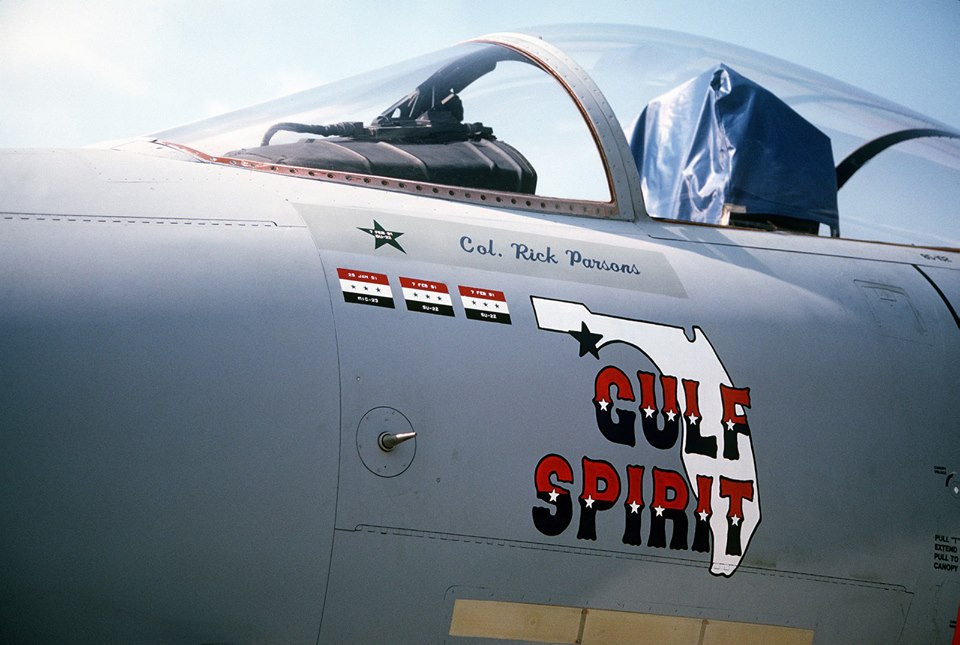
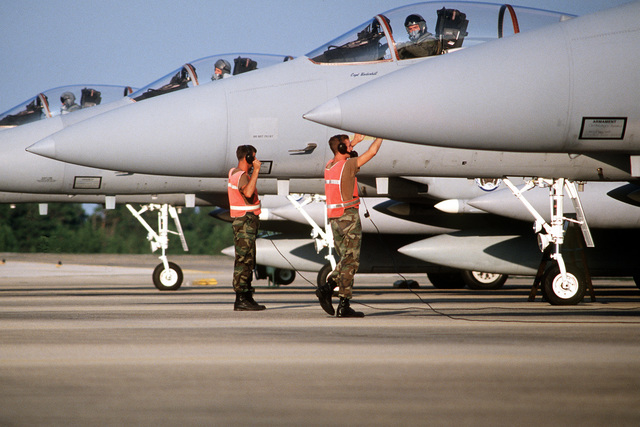
Some recent accomplishments of the 58th include: the first fighter squadron to bring the AIM-120 AMRAAM (Advanced Medium Range Air-to-Air Missile) into full operation, numerous rotations to the Saudi Arabian theater supporting Operation Southern Watch by patrolling the no-fly zone, and participation in Operation Uphold Democracy where the United States helped bring control back to Haiti.
During its scheduled rotation as part of Operation Southern Watch in 1996, tragedy struck the 58th Fighter Squadron. On June 25, one day before their scheduled departure, a terrorist bomb ripped through the
Khobar Towers complex that housed squadron personnel. When the dust cleared, nineteen U.S. personnel lay dead, twelve of which were members of the 33d Fighter Wing.
Currently, the 58th Fighter Squadron operates 27 F-15C/D Eagles and continues to support the various theater Commander-in Chiefs by providing air superiority to all who call upon its service.
Eglin’s ‘Mighty Gorillas’ own the skies
by Noel Getlin
Team Eglin Public Affairs
2/20/2009 – EGLIN AIR FORCE BASE, Fla. — Pilots stationed at Eglin fly a number of aircraft under three different wings. All have different missions, education and training, and therefore different approaches to flying. In this three-part series, we will examine the pilots of Eglin and what their unique missions bring to U.S. air superiority.
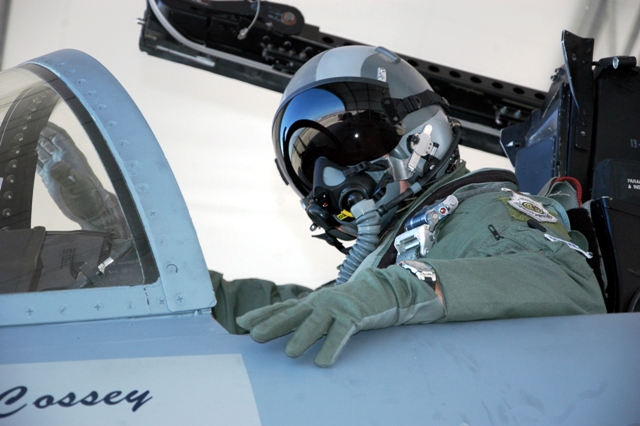
(photo above)Maj. Tony Cartwright, chief instructor pilot and weapons officer for the 58th Fighter Squadron, prepares for flight in an F-15C. The 33rd Fighter Wing’s fighter pilots fly F-15C Eagles in air-to-air combat. (U.S. Air Force photo/Noel Getlin)
The 58th Fighter Squadron’s “Mighty Gorillas” don’t wait for the fight to come to them; they go to the fight.
However, the combat pilots say the process of “getting there” is not nearly as important as what they do when they get there. That’s because the primary mission of the squadron is air-to-air combat.
“Very little is about the take off, the landing and the how we are going to get there,” said Maj. Tony Cartwright, chief instructor pilot and weapons officer of the 58th FS. “We spend a lot of time thinking about how we are going to employ (or fight).”
Because their day-to-day flying mission is purely air-to-air combat, they find themselves in a unique position since the Global War on Terrorism currently doesn’t have an airborne threat. Still, the squadron is a rapidly deployable combat unit and the pilots are always prepared to answer their nation’s call. Often, this call comes from Northern American Aerospace Defense Command requesting immediate support for an Operation Noble Eagle tasking.
“We are always prepared to deploy as a squadron,” said Capt. Vaimana Conner, electronic combat officer. “Our current mission priority is ONE. Since December, we’ve been flying combat air patrols protecting the president and ensuring air space is safe for space shuttle launches.”
The Gorillas are the only flying squadron at Eglin that deploys as a unit.
“Usually, when the 58th has deployed, 80 percent of the people and jets go to one site and fly missions based on the conflict or whatever we’re tasked to do,” Captain Conner said.
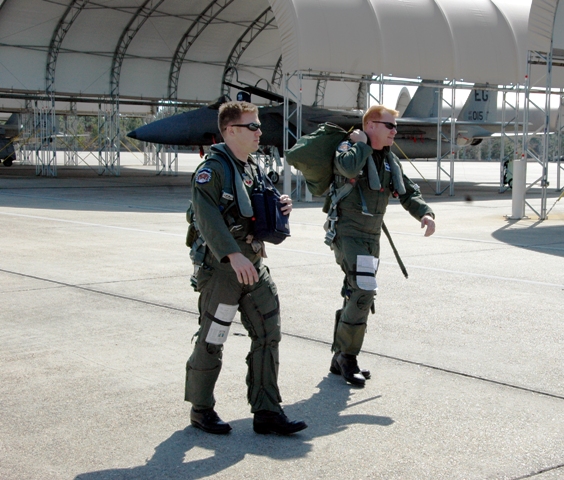
(photo left) Capt. Michael Reilly, 58th Fighter Squadron C Flight commander, and Maj. Tony Cartwright, chief instructor pilot and weapons officer for the 58th FS, walk out to the jets on the runway ramp. The 33rd Fighter Wing’s fighter pilots fly F-15C Eagles in air-to-air combat. (U.S. Air Force photo/Noel Getlin)
While they haven’t participated in air-to-air combat overseas recently, they are still making an impact.
“In the area of responsibility, freedom of movement cannot be done without air superiority,” said Major Cartwright. “If you do not dominate the skies, you cannot move UAVs and other things as freely as we do over there.”
“The supreme success of any armed force is to cause an adversary to behave according to our own designs without having to fire a shot,” added C Flight Commander Capt. Michael Reilly, paraphrasing military strategist Sun Tzu. “Any time we say, ‘we’ll be there in two weeks,’ and they bury their fighter jets under 60 feet of sand, we’ve accomplished our mission.”
To have that kind of bearing, credibility is critical and the squadron constantly trains for the next air-to-air threat.
The pilots train by swapping roles as good guys and bad guys in unit training missions and they analyze adversary aircraft tactics, weaponry and maneuvering characteristics. Whenever possible, they participate in dissimilar air combat training. The 33rd Fighter Wing pilots will alternately fly training missions with the 53rd Wing F-15s and F-16s and Tyndall Air Force Base, Fla., F-15s and F-22s. Occasionally, they fly with other airframes from visiting U.S. and foreign units, including the Royal Air Force’s Tornado F-3 and the Canadian F-18s.
The single-seat, F-15C Eagle is the lethal tool of the 33rd FW. The jet can reach speeds in excess of 1,875 mph or Mach 2 and is known to have “unprecedented maneuverability,” according to U.S. Air Force fact sheets. The jet can pull nine Gs, which is the effect the body experiences with the force of acceleration and gravity. When pilots experience high G forces, blood can rush from their head to their feet, causing tunnel vision and in some cases loss of consciousness. In order to oppose the physiological effects, pilots wear G suits, but they must also be in peak physical condition.
“It’s managing what’s happening at the speeds and the physical rigors of (combat flying) that defines what we do,” said Memphis, Tenn., native Major Cartwright.
Despite the fact that the fighter jets they fly are older than most of the pilots (they were built in 1978 to 1983), they have a true affection for the airframe.
“The F-15 is old and it doesn’t have a glass cockpit (computerized displays), but it’s the best at what it does,” said Maj. Cartwright. “It’s been in combat 104 times and it’s never lost.”
Captain Conner said the newer computerized color displays are nice, but the old steam gauges work just fine because you can essentially fly the F-15C by feel.
“This jet will talk to you,” added Major Cartwright. “When you ask it to do something, if it can do it, it will. If it can’t, it will try. You don’t even have to look inside (at the displays) to know what it’s doing … because you feel everything she’s doing. It’s good at what it does without having all the fancy stuff.”
All the fighter pilots are highly competitive; something they say is a necessity for the job. They compete for jobs, position in formations and upgrades.
“Being a fighter pilot is nonstop competition,” said Major Cartwright. “You know you are going to compete every time you do something.”
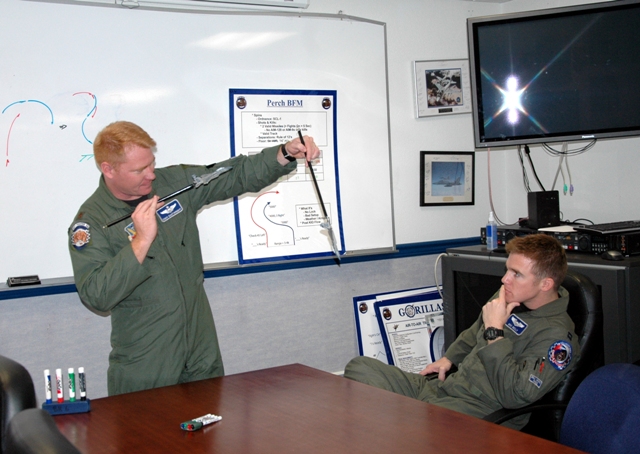
(photo above) Maj. Tony Cartwright, chief instructor pilot and weapons officer for the 58th Fighter Squadron, discusses air maneuvers in a debriefing room as Capt. Michael Reilly, 58th FS C Flight commander, listens. The 33rd Fighter Wing’s fighter pilots fly F-15C Eagles in air-to-air combat. (U.S. Air Force photo/Noel Getlin)
It begins when the pilot shows up at a new wing where they automatically begin on the bottom rung as a wingman. The flight instructors and director of operations decide when and if the pilot has progressed enough to be upgraded to a two-ship flight lead, then a four-ship flight lead (who can lead the standard F-15 employment formation into combat), and finally mission commander, who can lead eight to 12 Eagles in a stand-alone or integrated combat mission. At the top of the flying hierarchy are the instructor pilots, many of whom have been to the U.S. Air Force Weapons School.
“Upgrades are by competitive selection,” said Captain Conner. “It’s a rite of passage. And there’s no guarantee you are ever going to be upgraded.”
But the fighter pilot hierarchy is separate from the command structure, making for an unusual dichotomy.
“The dynamics are unique because you can have someone of higher rank who is not as high in the hierarchy,” Major Cartwright said, who has 1,200 flying hours.
There are other day-to-day duties to fulfill in squadron in addition to the flying missions. Pilots also take on the role of safety officer, scheduler, weapons officer, director of operations and flight commander, just to name a few. When it all comes down to it, actual flying time is just a small – but extremely important – part of their actual duties.
“I would call a 50- to 60-hour work week a light week for us,” said Captain Reilly, a native of Trenton, N.J.
For each mission, there’s mission planning, equipment checks and extensive discussion afterward in debriefings. This is where they review three tapes that record the Head’s Up Display (HUD), radar scope and tactical situation display. They also carry a telemetry pod that records the aircraft’s exact position and altitude throughout the mission for review after the flight. The pilots can spend up to a half hour discussing a maneuver that took only seconds to perform.
“For the operational guys, they’ll talk about it before the mission and when they get back,” said Major Cartwright. “The debrief is intensive. It’s like being in a constant scrimmage. Every time you get to look at the tapes, you see something you could have done better.”
Now that the 33rd FW is drawing down and transitioning to a Joint Strike Fighter training wing, the pilots once again find themselves competing for positions in fighter aircraft. Capt. Conner will be flying the F-22 but Cartwright and Reilly are still awaiting their fate. Of course, both are seeking a spot in a fighter squadron.
“The best part of being a fighter pilot is every day is a different challenge,” said Major Cartwright.
“As far as having a fun job, this is the perfect combination of intellect and athleticism,” said Captain Reilly. “You’ve really got to be on top of your game at both of these to be successful.”
Mighty Gorillas meet, say good-bye to Eagle
by Chrissy Cuttita Team Eglin Public Affairs
6/22/2009 – EGLIN AIR FORCE BASE, Fla. — During a week-long 58th Fighter Squadron reunion June 14-20, past and present pilots recounted stories of the good ‘ol days and shared the disheartening but mission essential fact that 30 years of F-15 Eagle driving will become history this year.
“This reunion is important to the 58th FS because we close our door to the operational world and become a training squadron,” said Capt. Brent Curtis, pilot and reunion event coordinator. “We have some of the greatest heritage of any fighter squadron post World War II, and arguably the greatest successes as an air to air squadron in the Gulf War.”
There to reminisce on the successful aerial victories were some of the squadron’s infamous “MiG killers.” One pilot in particular, retired Col. Cesar Rodriquez, a 26 year veteran, is well known for three air-to-air kills (two over Iraq in 1991 and one over Kosovo) were the most of any American fighter pilot on active duty.

“There’s a unique relationship with young fighter pilots to be the best and to live up to tradition,” the retired colonel said. “We knew the squadron history and knew of those who gave blood to make (squadron) colors stand high and proud.”
Activated as the 58th Pursuit Squadron as part of the 33rd Pursuit Group stationed at Mitchel Field, N.Y., the squadron was charged with the ongoing mission of aerial defense of the United States. When the United States entered World War II, the 58th took an active role in the war effort by participating in several operations during a three year overseas tour. During combat operations in the Mediterranean from November 1942 to February 1944, the squadron earned the nickname “Gorillas” for the guerrilla warfare-like techniques it utilized.
That name is still on their patch today and on the 58th Aircraft Maintenance unit banner “When Gorillas fly, MiGs die.” The first aerial shot at a MiG happened in the 1970s when the squadron was part of the then named 33rd Tactical Fighter Wing at Eglin. At that time three operational flying squadrons were a part of the wing and they flew and maintained F-4 Phantoms until transitioning to the F-15 by 1979.
“It was a special time. I’m really proud all our weapons officers ended up as MiG killers, as it should be, and three of four flight commanders ended up as MiG killers, as it should be,” said retired Col. Rich Hardy, 33rd FW vice wing commander 1988-1991 and Gorilla F-4 pilot 1979-1981. “We did it all with one squadron and never took a scratch.”
Even though he witnessed the first transition from Phantom to Eagle, the colonel said “the F-15 was the biggest and baddest of them all and to see it go doesn’t seem possible.”
Green stars circled around the squadron patch on their building and MiG killing aircraft mark the aerial victories achieved by the squadron.
“We had 16 kills in Desert Storm, the most of any fighter squadron in the Air Force. Gorillas lead the way in air superiority,” said Lt. Col. Mark O’Laughlin, 58th FS commander.
Retired Colonel Rodriquez remembers the 58th FS as 38 type-A bulls in a pen.
“The alpha male had to be the mission,” he said was the thing that bonded the competitive pilots into the family they became and the camaraderie they shared. “The focus ‘don’t be here for yourself but for the mission’ is what I learned here.”
Gorilla family, retired, active, spouse and children, were welcomed to an open house June 18 where they reunited and toured the facilities that will soon transition into a new Joint Strike Fighter training facility at the 33rd Fighter Wing. Past and present wing personnel, known as Nomads, had the same opportunity recently at a May wing reunion.
While the gathering last month was unique with the last F-15 West Coast Demo Team flight, the 58th FS was unique with its retirement ceremony for a well known Nomad warrior, Col. Scott Maw, who served at the wing first as a young lieutenant 1989-1992 and returned in 2006 to command the 33rd Operations Group. In 2008 he began a year-long tour in Iraq as a U.S. director of strategic communication, making him a key spokesperson for the military for worldwide media outlets.
Appropriately said at the ceremony was that the first assignment in the pilot community will always have significant impact on their career. Even retired Colonel Rodriquez echoed this – although his career started with A-10s, he remembers his first F-15 assignment at the 58th FS being especially memorable in becoming an Air Force leader and now civilian contractor.
“I feel like my fingerprint is on the past and present,” he said. “The F-35 will have its place in tomorrow’s battle space.”
To the fighter pilots who shared “there I was” stories of day to day sorties and combat missions, real and exercised, over the years, the reunion signified an end to the combat readiness of the 58th Fighter Squadron. There are only 10 aircraft left at the wing and the only flying opportunities left will mainly consist of moving them to other bases before October. Additionally they’ll keep up approximately eight daily sorties a day while they can to prepare pilots headed to the Air Force fighter weapons school at Nellis AFB, Nev.
“This reunion is a great time to celebrate, though it’s sad to go,” said Colonel O’Laughlin who will be the deputy of the 46th Operations Group here in his next assignment.
None of the people involved with this farewell will remain as personnel at the new Air Force F-35 training center this fall but they may be invited back for a future reunion as the wing and squadron names are planned to remain the same, continuing the Nomad legacy into the future.
Squadron photos
